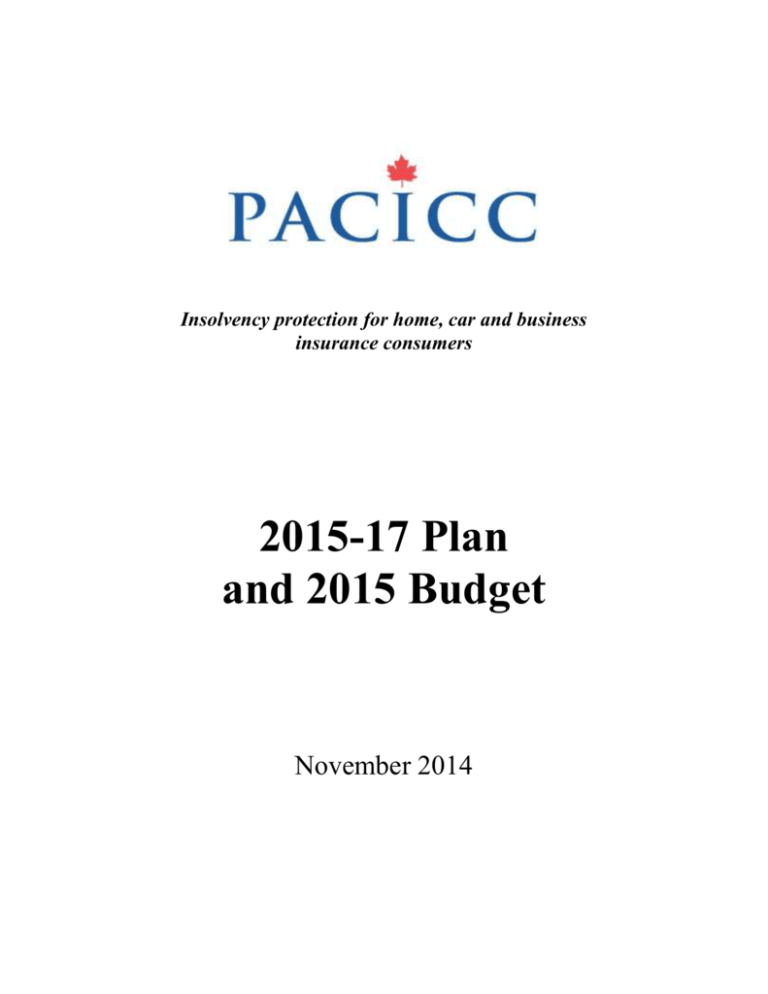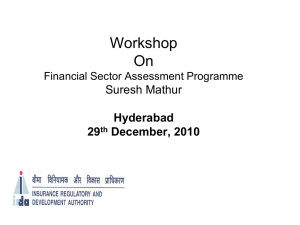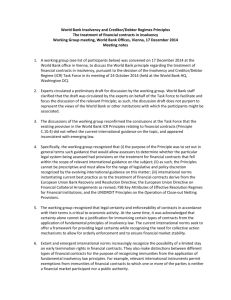Plan and Budget PACICC`s proposed plan for 2015
advertisement

Insolvency protection for home, car and business insurance consumers 2015-17 Plan and 2015 Budget November 2014 Contents Page Message from the President .................................................................................................1 Recent accomplishments .....................................................................................................2 Key deliverables for 2015 ...................................................................................................3 Mission and principles ........................................................................................................4 PACICC’s planning process ................................................................................................5 Risk Management report ......................................................................................................6 PACICC’s top-five risks ...................................................................................................6 Risk Officer’s Forum ........................................................................................................7 Priorities for the period 2015 to 2017: Securing an Emergency assessment mechanism (2015) ...................................................8 Reviewing PACICC’s coverage and benefits (2016) .......................................................9 Developing Protocols with Canada’s insurance regulators (2017) .................................10 PACICC’s operations priorities for 2015 to 2017 ..........................................................12 Update on PACICC Fund balances....................................................................................13 Projected 2014 revenue and spending, and proposed 2015 budget ...................................14 Message from the President Canada’s P&C insurance industry appears on track for a solid, if unspectacular, performance in 2014. Following the severe weather-related losses incurred last year ($1.7 billion in claims from flood damage in southern Alberta alone), it would not have been surprising to see underwriting performance bounce back this year. Thus far at least, that has not happened. Nonetheless, the industry’s capitalization continues to strengthen – increasing 4.8 percent year-over-year to a total of $45.7 billion. Correspondingly, the industry’s MCT ratio rose almost nine percentage points from a year earlier – to 246.5 percent. From a solvency perspective, PACICC welcomes the continued improvement in industry capitalization – which we view as a more sustainable metric, and one that provides a buffer against changing risks and other uncertainties that affect underwriting performance. PACICC’s main focus continues to be on preparedness – on our ability to protect policyholders in the event a member insurer becomes insolvent. Most recently, we have advocated that stronger actuarial standards be adopted by Canadian insurance regulators, consistent with the practices followed by OSFI and recommended by the IAIS. In the year ahead, we will work toward securing an Emergency funding mechanism to help our industry deal with potentially large financial demands that could result from a severe earthquake or other catastrophic event. One year ago, PACICC launched a new initiative by sponsoring a P&C insurance Risk Officer’s Forum in Canada. I’m pleased to say that the Risk Officer’s Forum has had a successful first year, attracting approximately 80 members across the industry, including some 45 member insurance company CRO’s. Building on this success, we are planning an ambitious program of in-person Forum meetings and webinars for 2015. As we continue our work on behalf of insurance consumers, PACICC’s Board of Directors and its management welcome feedback on any aspect of our plan and operations. Paul Kovacs President and CEO PACICC PACICC’s 2015-2017 Plan and 2015 Budget Page 1 Recent accomplishments Corporate governance (2004) PACICC took steps to modernize its corporate governance, including: adopting a corporate mission; downsizing the Board and streamlining Board Committees; introducing competitive compensation for public directors; and evaluating the Board’s performance. Financial preparedness (2005) The Corporation’s financial preparedness was enhanced by doubling PACICC’s potential maximum annual insolvency assessment; modeling future insolvency costs; and simulating the impact of shocks on the financial health of member insurers. Coverage and benefits (2006) We led a comprehensive review of PACICC’s coverage and benefits, ensuring that Canadians remain well protected in the unlikely event that a member insurer fails. PACICC harmonized covered lines to accord with CCIR’s classes of insurance, and raised its maximum benefit for personal property claims to $300,000. Enterprise risk management (2007) PACICC developed an ERM plan and strategy that is now embedded in our corporate governance practices. Initial action plans focused on mitigating six of PACICC’s own highest-rated risks. Insolvency legislation (2008) PACICC championed the call for a comprehensive review of the Winding-Up and Restructuring Act (WURA), identifying changes to improve the insolvency management framework for PACICC, our members, liquidators and regulators. Submissions outlining key reforms were made to Finance Canada and to the Senate Banking Committee. Reducing insolvency contagion risk (2009) PACICC undertook several projects in 2009 aimed at reducing contagion risk, including: participating in the reinsurance market review led by OSFI and AMF; communicating our research findings on how rate regulation impacts insurer solvency; and by proposing a liquidity facility to respond to the winding-up of a large insurer. Strengthening provincial solvency supervision (2010) PACICC updated its model wind-up order and Insurance Act provisions to address capital adequacy, investments and governance. Federal financial sector legislative review (2011) PACICC proposed a number of technical amendments to the WURA designed to improve the liquidation process; submitted a discussion paper on the resolution of complex failures, such as a financial conglomerate; and proposed new insolvency wording for use in reinsurance contracts. Promoting sound risk management (2012) After conducting a benchmark survey on membercompany ERM practices, PACICC worked with an advisory committee of Chief Risk Officers to deliver member-focused seminars on ERM standards, risk appetite and risk governance. Managing earthquake risk (2013) PACICC undertook detailed research and analysis to quantify the maximum catastrophic loss the Corporation could handle without threatening the solvency of otherwise healthy insurers. Findings were shared with key stakeholders. Promoting actuarial best practices (2014) PACICC worked with the actuarial profession in Canada to identify best practices to reduce insolvency risk, including appointed actuary requirements and mandatory reporting; peer review of estimates; and DCAT requirements. PACICC’s 2015-2017 Plan and 2015 Budget Page 2 Key deliverables for the year ahead PACICC’s priority issue for 2015 is to develop an Emergency assessment mechanism that would reduce the risk of contagion for PACICC members following an extreme catastrophic event. (See page 8 for more detail). PACICC will also continue its sponsorship of the Risk Officer’s Forum in Canada – consistent with our goal to reduce insurer solvency risk. And we will continue our successful solvency analysis research in 2015 by completing the ninth paper in PACICC’s Why insurers fail series – “The Role of Capital in Insurer Insolvencies.” PACICC’s operations priorities in 2015 include reviewing our: Banking service arrangements; and Information-technology service arrangements (the current contract with Insite Computer Group was put in place in 2006). PACICC’s 2015-2017 Plan and 2015 Budget Page 3 Mission and principles Mission Statement The mission of the Property and Casualty Insurance Compensation Corporation is to protect eligible policyholders from undue financial loss in the event that a member insurer becomes insolvent. We work to minimize the costs of insurer insolvencies and seek to maintain a high level of consumer and business confidence in Canada’s property and casualty insurance industry through the financial protection we provide to policyholders. Principles In the unlikely event that an insurance company becomes insolvent, policyholders should be protected from undue financial loss through prompt payment of covered claims. Financial preparedness is fundamental to PACICC’s successful management support of insurance company liquidations, requiring both adequate financial capacity and prudently managed compensation funds. Good corporate governance, well-informed stakeholders and cost-effective delivery of member services are foundations for success. Frequent and open consultations with members, regulators, liquidators and other stakeholders will strengthen PACICC’s performance. In-depth P&C insurance industry knowledge – based on applied research and analysis – is essential for effective monitoring of insolvency risk. PACICC’s 2015-2017 Plan and 2015 Budget Page 4 PACICC’s planning process PACICC’s Board of Directors has established a formal planning cycle focused on two regular meetings during the calendar year: Spring – PACICC staff present their evaluation to the Board summarizing the business environment for the Corporation, industry capitalization and measures of solvency risk. Staff analysis of individual company results remains confidential, so discussion with the Board focuses on trends in the number of insurers with weak regulatory capital scores, rapid premium growth, significant adjustments in loss reserves, and identification of member insurers unwilling to share financial results or other signs of vulnerability. Enterprise risk management (ERM) priority risks, ratings and action plans are reviewed by the Audit Committee and by the Board. Fall – The Board considers PACICC’s strategic plan, identifying the priority issues that the Corporation plans to address over the next three years, as well as the budget for the coming year. The main focus of the Plan is on the strategic priorities that PACICC will address and deliver on in the year ahead. ERM priority risks, ratings and action plans are reviewed by the Audit Committee. PACICC’s 2015-2017 Plan and 2015 Budget Page 5 Risk management report PACICC’s top-five risks Risk description Mitigation undertaken by PACICC Risk F1 – Insolvency costs could exceed PACICC’s available financial resources. Risk F1 – PACICC’s Board of Directors approved the option of establishing an industry liquidity facility to respond to potential extraordinary insolvency events. Risk F2 – Seismologists consider it inevitable that a major earthquake will someday strike Canada. Risk F2 – Management of this risk is PACICC’s strategic priority for 2013. Mitigation will be consistent with OSFI’s revised Earthquake Exposure Sound Practices Guideline. Risk R1 – Regulation of insurance rates may contribute to insurer solvency problems. Risk R1 – PACICC is conducting research to clarify best actuarial practices used in establishing insurance rates. Risk R2 – Provincial insurance supervisory frameworks may not meet the standards recommended by the International Association of Insurance Supervisors (IAIS). Risk R2 – PACICC has organized seminars on insolvency practices and procedures for several provincial insurance supervisors, including B.C., Alberta, Ontario and Newfoundland. Risk R3 – Insurance company winding-up and restructuring practices in Canada are outdated. Risk R3 – PACICC has made submissions to Federal Finance and Industry Canada advocating specific WURA reforms in connection with the review of financial sector legislation. Risk rating changes since last report No rating changes recommended (Note: Revisions in earthquake guidelines will reduce PACICC’s exposure over the next decade) No rating changes recommended (Note: PACICC will work with the new Solvency Committee of the Canadian Council of Insurance Regulators toward implementing IAIS standards) Notes: All of PACICC’s identified risks consider related reputation issues where applicable; we do not treat reputation risk as a separate risk category PACICC’s top-five risks represent the Corporation’s risk profile. This is part of the complete ERM Framework, a copy of which is posted on the Corporation’s website at www.pacicc.ca PACICC’s 2015-2017 Plan and 2015 Budget Page 6 Risk Officer’s Forum PACICC launched a P&C insurance Risk Officer’s Forum in December 2013 – in response to needs expressed by member companies for better sharing of information on effective ERM practices. Over the past year, the Risk Officer’s Forum has attracted a solid membership base of approximately 80 risk professionals across the industry, including some 45 member insurance company CRO’s. Three in-person Forum meetings have been held, supported by expert panel discussions and guest speakers, and covering relevant topics like ORSA, key metrics and emerging risks. Several webinars led by subject-matter experts have also been organized by the Risk Officer’s Forum. Holding a Forum meeting following OSFI’s annual Risk Management Seminar has become an established practice, allowing the Forum to reach more out-of-town members attending the OSFI event. The Forum is guided by an Advisory Committee of member-company CRO’s and is Chaired by Susan Meltzer of Aviva Canada. The Risk Officer’s Forum has developed a mandate statement, which is to: discuss and share ERM best practices and benchmarks for the industry review and communicate topical ERM information with members and stakeholders serve as a consultative ERM resource for insurance regulators and PACICC discuss major existing and emerging risks impacting the industry provide members references and information to facilitate research of risks, ERM and related regulatory and governance topics. Looking ahead, the Risk Officer’s Forum is planning the following program for 2015:* Forum meetings Webinars April – ERM Best Practices March – Social Media September – Embedding ERM June – Product Risk December – OSFI Risk Management Seminar debrief October – Use of Models & Stress Testing ____________________________________________________________________ * Specific dates for these events will be announced before year-end 2014. PACICC’s 2015-2017 Plan and 2015 Budget Page 7 Priorities for the period 2015 to 2017 Priority for 2015 Securing an Emergency assessment mechanism PACICC’s existing funding model has worked as intended for more than 25 years to protect insurance consumers from financial hardship should their property and casualty insurance company become insolvent. However, our recent research shows that PACICC’s current funding model could fail to protect consumers if the Corporation was faced with an extreme catastrophe loss, or if multiple insurers were to become insolvent in the same year. In such a scenario, PACICC could be confronted with serious liquidity problems and be unable to pay eligible policyholder claims on a timely basis. Moreover, PACICC’s assessments on insurers could inadvertently create liabilities so large that otherwise healthy insurers could fail regulatory solvency tests. PACICC’s proposed priority for 2015 is thus to: Develop an Emergency assessment mechanism that would reduce the risk of contagion for PACICC members following an extreme catastrophic event; Consult with members and other stakeholders to obtain input on the design and operation of the Emergency assessment mechanism; and Obtain regulatory and member approval for the mechanism. PACICC’s 2015-2017 Plan and 2015 Budget Page 8 Priorities for the period 2015 to 2017 (continued) Priority for 2016 Reviewing PACICC’s coverage and benefits PACICC last reviewed its coverage and benefits in 2006. We believe it is appropriate to review coverage and benefits approximately once every 10 years – thus the proposal to do so in 2016. The last review in 2006 resulted in one significant change being made – the limit on personal property coverage was increased to a maximum of $300,000 per claim. (All other PACICC claims limits remained at a maximum of $250,000). PACICC has conducted research to help benchmark best practices of insurance guarantee funds in other jurisdictions. The results of this research will inform our planned review of coverage and benefits. Our review will examine the full range of PACICC coverage and benefits, including the current limit on refunds of unearned premiums. Depending on Board direction and our research findings, PACICC may choose to re-examine whether coverage should continue to be extended to large commercial insureds. Consultations with key stakeholders – including insurance consumers, regulators and liquidators – will be part of the coverage and benefits review process. PACICC’s 2015-2017 Plan and 2015 Budget Page 9 Priorities for the period 2015 to 2017 (continued) Recommended priority for 2017 Developing Protocols with Canada’s insurance regulators Maintaining clear and effective working relationships with insurance regulators is key to PACICC being able to fulfill its mission to protect insurance policyholders – especially in the event of a member insolvency. While PACICC maintains regular, proactive contact with OSFI and provincial and territorial insurance supervisors, there is additional benefit in documenting roles and responsibilities in the form of protocols. PACICC has completed one such protocol with Ontario (FSCO), and another draft protocol is under discussion with Quebec (AMF). To ensure consistency of approach and to minimize potential gaps, PACICC proposes to develop protocols with all insurance supervisory authorities in Canada. In addition to supporting the rationale set out above, the protocols could be expected to address the following: The conditions required by regulators to exchange confidential information with PACICC concerning potentially troubled member insurers. One mechanism being discussed is for PACICC to create a Committee of its Board of Directors (likely composed entirely of its public directors) for purposes of liaising with regulators regarding confidential member company information. If PACICC is successful in creating an Emergency funding mechanism, the operational features of that mechanism could be embedded in the protocols. Three alternative issues for the Board of Directors to consider Insurer insolvency risk within a financial conglomerate Building on what the G-20 endorsed in 2011 as a new international standard (Key Attributes of Effective Resolution Regimes for Financial Institutions): Examine the specific risks that PACICC could face in Canada if a conglomerate that included a member P&C insurer failed Does PACICC have the necessary tools and mechanisms in place to fulfill its mission in this scenario? If not, what gaps exist and what do we need to do to address them? Price adequacy and insurer insolvency Extend and update PACICC’s research on this issue from the 2009 Why insurers fail study (focusing on Canada and selected other jurisdictions) Has anything changed? Are our fundamental conclusions still the same? Proactively target senior government officials and regulators and challenge the basis and rationale for regulating insurance rates. PACICC’s 2015-2017 Plan and 2015 Budget Page 10 Key stakeholder review During its 25-year history, PACICC’s consultations with stakeholders have been conducted as needed and in response to specific issues A different and more proactive approach could see PACICC – as a mature organization with a successful track record of protecting insurance consumers – consult broadly and more formally with its key stakeholders to ensure we are meeting their expectations Findings from the recent OECD international study of guarantee fund practices would be considered as part of a broad stakeholder review Key stakeholders would include member insurance companies, insurance consumers, insurance regulators, and insurance brokers. PACICC’s 2015-2017 Plan and 2015 Budget Page 11 PACICC’s operations priorities for 2015 to 2017 Because preparedness is a constant requirement, PACICC also identifies its operational priorities separately from the strategic policy priorities approved each year by the Board of Directors. 2015 Review PACICC’s banking service arrangements. Review PACICC’s information-technology service arrangements (current contract with Insite Computer Group was put in place in 2006). 2016 Review PACICC’s investment management services, guided by the Audit & Risk Committee (the last such review was done in 2007-08). Review PACICC’s external audit services, guided by the Audit & Risk Committee. 2017 Review PACICC’s physical office space requirements in advance of the Corporation’s current lease expiry (December 31, 2017). PACICC’s 2015-2017 Plan and 2015 Budget Page 12 Update on PACICC Fund balances PACICC Liquidation Funds Beothic General Canadian Universal Ontario General Hiland Gisco Canadian Millers’ Markham General Total Balances on September 30, 2014 $269,969 $817,793 $612,674 $565,203 $2,702,511 $675,140 $10,941,305 $16,584,595 Balances projected to December 31, 2014 $270,645 $819,830 $614,200 $566,600 $2,709,260 $676,825 $10,968,650 $16,626,010 PACICC Compensation Fund Balance Total market value on September 30, 2014 $50,945,040 Total market value projected to December 31, 2014 $51,350,500 PACICC Operating Fund Balance Total on September 30, 2014 $2,037,400 Total projected to December 31, 2014 $1,683,500 PACICC’s 2015-2017 Plan and 2015 Budget Page 13 Projected 2014 revenue and spending, and proposed 2015 budget Budget 2014 Projected 2014 Proposed 2015 Revenues Administrative assessment Investment income Funding from liquidation funds Funding from ICLR $1,346,000 $18,000 $85,000 $100,000 $1,346,000 $18,000 $85,000 $100,000 $1,380,000 $15,000 $75,000 $100,000 Total Revenue $1,549,000 $1,549,000 $1,570,000 Spending Salaries Benefits Sub-total: salaries and benefits $647,000 $143,000 $790,000 $645,000 $95,000 $740,000 $661,000 $98,000 $759,000 Research and other consulting Legal fees Premises Corp. secretary, finance & admin. Travel Directors’ fees and expenses Furniture and equipment Telephone and postage Insurance Annual report and other printing Investment mgt and banking fees Audit and other expenses Expense contingencies $165,000 $55,000 $140,000 $45,000 $35,000 $75,000 $20,000 $25,000 $16,000 $20,000 $81,000 $77,000 $5,000 $165,000 $50,000 $140,000 $45,000 $43,000 $75,000 $20,000 $25,000 $16,000 $18,000 $81,000 $77,000 $5,000 $195,000 $40,000 $145,000 $45,000 $40,000 $80,000 $20,000 $30,000 $16,000 $17,000 $84,000 $79,000 20,000 $759,000 $760,000 $811,000 $1,549,000 $1,500,000 $1,570,000 Sub-total: non-salary expenses Total Spending Notes The projected surplus of $49,000 in revenue compared to expenditures in 2014 was due primarily to a staff vacancy during the year. (The position will be filled in 2015). Administrative assessments for 2015 are projected to increase on average by 2.5 percent. Budgeting for 2015 assumes that salary and benefits costs will increase by 2.5 percent on average. PACICC’s 2015-2017 Plan and 2015 Budget Page 14








